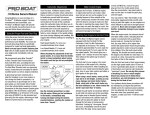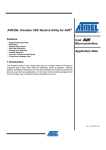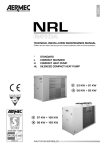Download Dynamite Specialty Products .15S User's Manual
Transcript
® 15 Dynamite .15S Water-Cooled Engine Instruction Manual Thank you for purchasing the Dynamite .15S marine engine. We are confident that you will enjoy many hours of exciting R/C boating action with this engine as your power plant. Please read the instructions carefully in order to get the most out of your Dynamite Engine. Water-Cooled Because your Dynamite .15S engine is water-cooled, make sure that you do not run the engine for an extended period of time outside of the water. Also, continually monitor the water-outlet while operating to make sure that the water continues to circulate through the cylinder head. If the tubing gets clogged or for some other reason prohibits the water from circulating through the cylinder head, the engine will overheat and fail. This could cause permanent damage to the engine. It is very important that you properly hookup the water pickup line to the engine to provide the necessary cooling. Double Taper Piston/Sleeve Your Dynamite .15S Engine features a double-taper piston and sleeve. Each piston and sleeve is hand matched. Replacement piston and sleeves are sold as a set since you never want to replace just the piston or the sleeve individually. Crankcase Porting Your Dynamite .15 Engine has a third port that is machined into the crankcase to significantly enhance the intake flow, resulting in more horsepower. Crankshaft Balancing The .15S provides a well-balanced crankshaft, which offers a smoother running and more efficient engine and will help create more horsepower and reliability. Section 1: Using the Proper Fuel and Glow Plug To achieve reliability and proper tuning of any 2-cycle model engine, it is highly recommended that you use fuel and glow plugs that are specially designed for these types of engines. Do not use any type of airplane glow fuel. We recommend using Blue ThunderTM First Run Break-In Fuel for the first six tanks of running. This fuel will ensure maximum life of your new and/or rebuilt engine. After proper break-in, switch to Blue Thunder regular fuel or Blue Thunder Race Formula blend. These fuels are vigorously researched and specifically formulated for excellent power and engine protection. Blue Thunder—the #1 car fuel in America! The Dynamite MC-59 McCoy Power Plugs (DYN2508) will provide the best performance and longevity for your engine. Section 2: Pro Mix Carburetor Your .15S comes equipped with the Dynamite Pro Mix Carburetor. Each Pro Mix Carburetor is preadjusted to make starting easier. This setting should give you a "rich" mixture of fuel to your engine. This setting is approximately 2 turns open for the highspeed and 7 turns open for the low-speed needle. Richer When the engine starts, the muffler should emit excessive white/blue smoke, and the engine should be rich to such an extent that it is not providing horsepower or idling smoothly. During the first tank of fuel, advance the idle via the idle adjustment screw more than normal to prevent stalling at idle due to the rich fuel mixture for break-in. High-Speed Needle Valve For the break-in period, we recommend a slightly rich low-speed needle setting and a very rich high-speed needle setting for the first few tanks. Again, if the engine does not start after several tries, refer to the Troubleshooting Guide or call the Horizon Service Center at (217) 355-9511. Idle Adjustment Screw Higher Idle does not start, refer to the Troubleshooting Guide in the manual. You may have to "blip" the throttle on the transmitter (applying throttle on/off) while trying to start the engine. New engines are harder to start because of the tight piston/sleeve fit. Never start an engine to full throttle. Over-revving an engine will cause premature wear and breakage. Low-Speed Needle Valve Leaner If you have difficulty starting your engine, check the factory setting. When checking the number of turns the high-speed needle is open, screw the needle clockwise (leans out the fuel mixture) using a straight tip Tuning Screwdriver (DYN2775) and count the number of complete revolutions of the needle until it stops turning. (Do not tighten down on the needle valve.) Then unscrew the needle valve (counterclockwise, giving more fuel to the engine) 2 turns before attempting to start the engine again. When checking the low-speed needle, it is critical that the throttle barrel is closed when screwing in the low-speed needle and that you don’t over-tighten the needle. Use the same procedure above for checking the low-speed needle. Section 3: Breaking in Your Engine The first start-up of your engine is the most critical moment of your engine’s life, dictating how it will perform from that time forward. Turn on the radio system and attach a glow driver (DYN1925-DYN1950) to the glow plug. Start the engine with the pull starter that is included on your engine. Note: When using the pull-start of your engine, never pull the rope out to its full length, as doing so may cause damage and the rope may not retract. Quick, short pulls of the starter rope are the best technique to use with the pull starter. If the pull starter is very hard to pull (i.e., it will not extend out of the pull starter assembly), the engine may be hydro-locked. Excessive fuel between the head and piston will not let the piston travel to TDC (Top Dead Center). Loosen the plug one turn and try to start the engine. If the engine starts, retighten the plug with the attached glow driver while the engine is running. If the engine After you get the engine started, drive your boat around varying the throttle of your transmitter on and off through one tank of fuel, making sure that the engine is rich. Make sure that you do not travel too far from shore at this time, as it may be necessary to retrieve it if the engine dies. After two or three tanks of fuel, start leaning out the high-speed needle 1/16" at a time. It generally takes about five to six tanks before you want to lean out the engine until it supplies good power. Do not skip this process of breaking in the engine. If you do not follow this procedure, you could cause damage to your engine. Remember, be patient during your first start-ups and runs. With a high-performance engine like the .15S, first run attempts can take some time. Once you are through the break-in process, your patience will be rewarded. You will have an engine that is easier to start, tunes more consistently, and has more power. Note: It is common for an ABC engine to go through a glow plug or two during break-in. To test the plug, let the engine idle at a properly adjusted low-speed needle setting with the glow driver on. Then remove the glow driver. If the plug is good, you will not hear a rpm change in the engine. If the engine loads up and the rpm falls off, the glow plug will need to be replaced. Section 4: Setting the Needle Valves When adjusting the needle valves for maximum performance, adjust the needles in small increments, just 1/8 of a full turn at a time. The worst thing you can do is to run the engine too lean—doing so shortens the reliability of the engine. When the engine is set too lean, it will run strong at first but will then sag, hesitate, or stall when accelerating. Tuning the High-Speed Needle To check the high-speed needle, start the engine and run the boat in the water for 1-2 minutes. Then bring the boat back in shore. Place a few drops of water on the head. If the water immediately evaporates, the setting is too lean. If it takes about 3-5 seconds before the water evaporates, the settings are correct. If the water stays on the head longer than 5 seconds without evaporating, set the boat back in the water and run it for an additional 1-2 minutes. If you repeat this procedure and the water is still not evaporating within 3-5 seconds, the setting is too rich. To lean out the engine, simply turn the high-speed needle clockwise 1/8 of a turn and run the engine again. Continue doing this until the high-speed needle is set correctly. Tuning the Low-Speed Needle It is best to tune the low-speed needle after setting the high-speed needle. When you have achieved the proper operating temperature, idle the engine and pinch the fuel line with you fingers at the fuel inlet nipple of the carburetor. If the engine dies immediately, the low end is set too lean. When you pinch the fuel line, the rpm should increase for about 4 seconds, and then the engine should die. To achieve the correct setting, always adjust the needle only 1/16 of a full turn, then test it before continuing. After you have attained the correct needle settings, the engine will have a strong sounding, high-pitched whine at full speed. A thin trail of whitish smoke will be seen coming from the exhaust. Idle Adjustment The last setting on your engine is the idle screw. To obtain a higher idle, turn the idle screw clockwise; for lower idle, turn the idle screw counterclockwise. Section 5: Engine Maintenance To ensure that your engine maintains its high performance and reliability, periodic maintenance must be performed. After each day’s use of the engine, it is important to use a high-quality "after run" oil or fuel in the engine. The methanol used in the fuel draws moisture that can cause corrosion inside the engine. We highly recommend Blue ThunderTM Final Run (DYN2255) as it is formulated specifically for protecting your engine when it is not in use. Follow these steps after each day’s use of the engine. • Empty all excess fuel from the fuel tank • Use Final Run Fuel following the Final Run instructions • Clean and inspect the outside of the engine Changing the Rod With the rod having most of the stress of any other part of a 2-cycle engine, it is important to replace the rod after every 2 gallons of fuel that has been run through the engine. This is a safe time frame for replacing the rod as it is less expensive to install a new rod than taking the chance of having it break and damage the engine. To replace the rod, refer to the line drawing on the back of the manual. Study the drawing carefully and pay close attention when removing the piston , sleeve, and rod. They must be installed exactly in their original position in order to avoid damaging your engine. If you have any questions about this procedure, please see your local hobby retailer or contact the Horizon Service Center. Section 6: Troubleshooting Guide PROBLEM POSSIBLE SOLUTION Engine won’t start Reset needles to the factory setting Improper needle setting Out of fuel Improper fuel Improper glow plug Glow starter not charged Dead glow plug Engine flooded Engine starts, then dies Engine runs for partial tank, then dies Pressure line blocked or unhooked Reset needles to baseline setting Improper needle settings Bad glow plug Idle speed set too low Improper needle settings Overheated engine Glow plug failed due to lean engine setting Section 7: Replacing the Pull Starter If you need to replace the pull starter of your .15S, remove the three screws from the pull starter case. Be very careful when taking the pull starter case off of the engine and make sure the recoil spring does not dislodge from the unit. The recoil spring is very difficult to wind back onto the rope pulley and install back into the pull starter case. In most cases, it is easier to have a replacement Recoil Spring in your pit box (DYN6542) or Pull Starter unit (DYN6535), which includes the recoil spring, rope/pulley, and pull starter housing. For other replacement parts for the pull starter and disassembling guidance, refer to the line drawing in the manual. When reassembling the pull starter, be absolutely sure that each part is oriented in the correct manner. • Damage due to improper disassembly or re-assembly • Modification of any kind • Normal engine wear If your engine is in need of repair, please follow these steps: 1. Ship your engine in its original box (packaged in a sturdy box) freight prepaid to: Horizon Service Center ATTN: Dynamite Service 4105 Fieldstone Rd. Champaign, IL 61822 (217) 355-9511 2. Include a note containing a brief summary of the difficulty you are experiencing and include the following information: • Nitro content and brand of fuel • Type of glow plug used • Type of air filter used • Approximately how much running time the engine had before experiencing difficulty Please date your correspondence and be sure your name and address appear on this enclosure. Also include a daytime phone number. 3. Warranty Repair: To receive warranty service, you must include your original dated sales receipt to verify proof-of-purchase date. Providing warranty conditions have been met, your engine will be repaired free of charge. 4. Non-Warranty Repairs: Should your repair cost exceed $50.00, you will be provided with an estimate advising you of your options. Any return freight for non-warranty repairs will be billed to you. 5. Payment Method: Please advise the Horizon Service Center of the payment method you prefer to use. Please specify Visa or MasterCard, or you may mail in a money order with the correct total when repairs are completed. If you prefer to use your credit card, please include your card number and expiration date. DYN6502 DYN6520 DYN6522 DYN6523 DYN6524 DYN6529 DYN6530 DYN6531 DYN6532 DYN6535 DYN6536 DYN6537 DYN6538 DYN6539 DYN6540 DYN6541 DYN6542 DYN6543 DYN6550 DYN6551 DYN6552 DYN6553 DYN6554 DYN6555 DYN6556 DYN6557 DYN6558 DYN6559 DYN6560 DYN6561 DYN6562 DYN6565 DYN6571 DYN6572 DYN6573 DYN6574 DYN6575 DYN6576 .15S Water-Cooled, Universal 139.95 Connecting Rod: 12S, 12SPD, 15S 19.95 Head Shims, .01, .02: 12SPD, 15S 3.95 Screw Set: 12S, 12SPD, w/o PS (8), 15S 3.95 PS Uni-Crankshaft: 12S, SPD, 15S 19.95 Flywheel Hub: 12S, 12SPD, 15S 1.95 Crankshaft Nut: 12S, 12SPD, 15S 1.95 Front Sealed Bearing: 12S, 12SPD, 15S 6.95 Rear Bearing: 12S, 12SPD, 15S 8.95 Pull Starter: 12S, 12SPD, 15S 19.95 PS Backplate: 12S, 12SPD, 15S 6.95 PS One-Way Bearing, 15S 12.95 PS Shaft: 12S, 12SPD, 15S 2.95 PS Cushion Spring: 12S, 12SPD, 15S 1.95 PS Screw Set: 12S, 12SPD, 15S 2.95 PS Handle w/Cotter & Extension: 12S, 12SPD, 15S 3.95 PS Recoil Spring: 12S, 12SPD, 15S 4.95 PS Rope/Pully: 12S, 12SPD, 15S 2.95 Carburetor: 12S, 12SPD, 15S 24.95 Carburetor Body w/Spray Bar: 12S, 12SPD, 15S 12.95 Throttle Barrel: 12S, 12SPD, 15S 5.95 Throttle Barrel Boot: 12S, 12SPD, 15S 2.95 Throttle Arm w/Nut: 12S, 12SPD, 15S 2.95 High Speed Needle Valve: 12S, 12SPD, 15S 4.95 High Speed Needle Holder: 12S, 12SPD, 15S 4.95 High Speed Assembly Washers: 12S, 12SPD, 15S 2.95 Fuel Inlet Nipple: 12S, 12SPD, 15S 2.95 Low Speed Needle Valve: 12S, 12SPD, 15S 4.95 Idle Screw w/Spring: 12S, 12SPD, 15S 2.95 Carburetor Cinch Bolt: 12S, 12SPD, 15S 3.95 Throttle Barrel Spring: 12S, 12SPD, 15S 1.95 O-Ring Set, Complete: 12S, 12SPD, 15S 2.95 Water-Cooled Head: 15S 15.95 Piston Pin w/2 Clips: 15S 2.95 Combustion Chamber: 15S 5.95 Crankcase: 15S 18.95 O Ring Set: Water-Cooled Head 3.95 Piston/Cylinder Set: 15S 34.95 DYN6523 (4) DYN6571 DYN6575 DYN6522 DYN6573 DYN6576 DYN6572 DYN6520 DYN6550 DYN6565 DYN6574 DYN6529 DYN6530 DYN6531 DYN6561 DYN6532 DYN6524 DYN6565 DYN6555 DYN6565 DYN6556 Section 8: Warranty Dynamite’s engines are guaranteed against workmanship and manufacturing defects for period of 2 years from the original date of purchase. This engine is of excellent design and materials and will provide many hours of modeling enjoyment If properly cared for, this engine is extremely durable. However, if normal common sense care is not given to your engine, it will not function properly for as long as intended. The following items can shorten its life and will not be covered under warranty: • Damage due to insufficient maintenance • Damage related to over-revving the engine • Rusted bearings • Crash related damage • Damage due to use of improper fuel and/or glow plug • Damage due to lean runs • Damage caused by foreign objects such as dirt or broken glow plug elements • Damage caused by unreasonable mounting or running conditions Parts Listing: Richer DYN6557 DYN6558 DYN6535 Ldle Adjustment Screw DYN6560 DYN6551 Higher Idle Low-Speed Needle Valve Leaner DYN6562 DYN6552 DYN6565 High-Speed Needle Valve DYN6553 DYN6565 DYN6559 DYN6554 DYN6537 DYN6565 DYN6536 DYN6540 DYN6538 DYN6539 DYN6543 DYN6542 DYN6535 DYN6540 DYN6541




